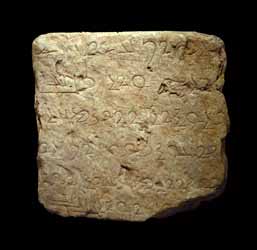Sassanian Limestone Block with Pahlavi Inscription, 400 CE - 600 CE
Limestone
46.4 x 47 cm
18 1/4 x 18 1/2 in
18 1/4 x 18 1/2 in
PF.5867
The Sassanids were the last native Persian Kingdom to rule Ancient Iran before the Islamic conquest, roughly from the 3rd to the 7th Century A.D. and a potent foe of...
The Sassanids were the last native Persian Kingdom to rule Ancient Iran before the Islamic conquest, roughly from the 3rd to the 7th Century A.D. and a potent foe of the Romans. The Sassanid era was a golden age of Persian culture that witnessed the revival of Zoroastrianism, an ancient mystical belief native to these lands, and a literary Renaissance spurred by the translation of many Old Persian epics written in cuneiform into Pahlavi. Written in an alphabet derived from Aramaic, Pahlavi, also known as Middle Persian, was the language of Ancient Iran that followed Old Perisan. In turn, Pahlavi was supplanted by modern Persian so it can be viewed as a transitional language that links the end of the Ancient Persian Empire conquered by Alexander the Great with the rise of the Islamic Dynasties.
Based on the style of the inscription, it is probable that this block is a fragment of the Paikuli monument. Although this particular block has not yet been properly documented by scholars of the Paikuli Pahlavi text, this monument was destroyed by an earthquake and there are several missing pieces which have been scattered over a wide area. Experts agree that this fragment is most likely such a missing block, unless one assumes that other similar monumental inscriptions once existed in Iran. Professor P.O. Skjaervo of Harvard University has analyzed the work first hand and believes that it does indeed come from the Paikuli monument. He noted that this block joins neatly to another block that is known to come from this monument.
The six lines of inscription have been translated; however, the lines are mere fragments of a much greater text and are therefore disjointed. Regardless, the translation reads as follows, “to Ardashir…us at the great…went out from and…
to Au[hrmizd]…when Wahu[nam (?)]…
and at court…” As one can see, the lines are so disconnected as to make it impossible to surmise what may be detailed in the missing parts. However, the translation does bring to light one important feature of this block, the presence of the name of King Ardashir. King Ardashir was the founder of the Sassanid Empire who established Zoroastrianism as the state religion. His life and reign were memorialized in the historical text, Karnamik-I-Ardashir, or The Records of Ardashir.
Based on the style of the inscription, it is probable that this block is a fragment of the Paikuli monument. Although this particular block has not yet been properly documented by scholars of the Paikuli Pahlavi text, this monument was destroyed by an earthquake and there are several missing pieces which have been scattered over a wide area. Experts agree that this fragment is most likely such a missing block, unless one assumes that other similar monumental inscriptions once existed in Iran. Professor P.O. Skjaervo of Harvard University has analyzed the work first hand and believes that it does indeed come from the Paikuli monument. He noted that this block joins neatly to another block that is known to come from this monument.
The six lines of inscription have been translated; however, the lines are mere fragments of a much greater text and are therefore disjointed. Regardless, the translation reads as follows, “to Ardashir…us at the great…went out from and…
to Au[hrmizd]…when Wahu[nam (?)]…
and at court…” As one can see, the lines are so disconnected as to make it impossible to surmise what may be detailed in the missing parts. However, the translation does bring to light one important feature of this block, the presence of the name of King Ardashir. King Ardashir was the founder of the Sassanid Empire who established Zoroastrianism as the state religion. His life and reign were memorialized in the historical text, Karnamik-I-Ardashir, or The Records of Ardashir.
